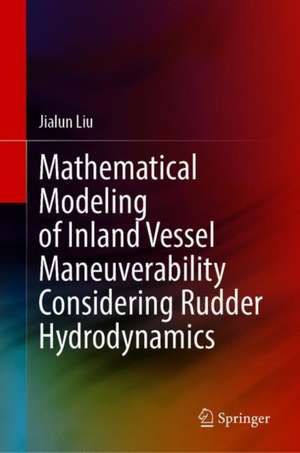Mathematical Modeling of Inland Vessel Maneuverability Considering Rudder Hydrodynamics
Autor Jialun Liuen Limba Engleză Hardback – 12 mai 2020
| Toate formatele și edițiile | Preț | Express |
|---|---|---|
| Paperback (1) | 638.76 lei 6-8 săpt. | |
| Springer International Publishing – 12 mai 2021 | 638.76 lei 6-8 săpt. | |
| Hardback (1) | 644.95 lei 6-8 săpt. | |
| Springer International Publishing – 12 mai 2020 | 644.95 lei 6-8 săpt. |
Preț: 644.95 lei
Preț vechi: 758.77 lei
-15% Nou
Puncte Express: 967
Preț estimativ în valută:
123.43€ • 127.51$ • 102.72£
123.43€ • 127.51$ • 102.72£
Carte tipărită la comandă
Livrare economică 26 martie-09 aprilie
Preluare comenzi: 021 569.72.76
Specificații
ISBN-13: 9783030474744
ISBN-10: 3030474747
Ilustrații: XXIII, 237 p. 129 illus., 93 illus. in color.
Dimensiuni: 155 x 235 mm
Greutate: 0.54 kg
Ediția:1st ed. 2020
Editura: Springer International Publishing
Colecția Springer
Locul publicării:Cham, Switzerland
ISBN-10: 3030474747
Ilustrații: XXIII, 237 p. 129 illus., 93 illus. in color.
Dimensiuni: 155 x 235 mm
Greutate: 0.54 kg
Ediția:1st ed. 2020
Editura: Springer International Publishing
Colecția Springer
Locul publicării:Cham, Switzerland
Cuprins
Introduction.- Design and evaluation of ship rudders.- Computational fluid dynamics methods of ship rudders.- Hydro dynamic characteristics of ship rudders.- A primer of inland vessel maneuverability
Notă biografică
Dr. Jialun Liu is an Associate Professor in Intelligent Transportation Systems Research Center, Wuhan University of Technology, and a member of National Engineering Research Center for Water Transport Safety. From 2006 to 2010, he studied at Wuhan University of Technology, Wuhan, China, specializing in Navigation Technology. From 2008 to 2010, he minored in Japanese at Huazhong University of Science and Technology, Wuhan, China. He obtained his B.Sc. and B.A. degrees in 2010 from these two universities, respectively. After that, he was recommended to continue master education at Wuhan University of Technology in Traffic Engineering and Control. In 2012, he was founded by China Scholarship Council and started his Ph.D. research at Delft University of Technology, Delft, the Netherlands. In 2013, he received his M.Sc. degree. From 2012 to 2017, Jialun Liu worked at the section of Ship Design, Operation, and Production in the Department of Marine and Transportation Technology. From March 2017, he started working at Wuhan University of Technology. He received “Chutian Excellent Young Scholar” in 2017 and got promoted to be an Associate Professor. He has been appointed as reviewers of Ocean Engineering, Ships and Offshore Structures, Journal of Marine Science and Technology, International Journal of Naval Architecture and Ocean Engineering, and other international journals and conferences. He has interests in maneuvering modeling and motion control of ships, applications of computational fluid dynamics methods to maritime engineering, developments of autonomous ships, and functional testing of smart ships.
Textul de pe ultima copertă
This book demonstrates that different rudder configurations have different hydrodynamic characteristics, which are influenced by the profile, the parameters, and the specific configuration. The author proposes new regression formulas to help naval architects quickly estimate the rudder-induced forces and moments in maneuvering. Furthermore, the author proposes and validates an integrated maneuvering model for both seagoing ships and inland vessels. Using the proposed regression formulas and maneuvering model, the specific impacts of rudder configurations on inland vessel maneuverability are studied. In turn, the book demonstrates the application of Reynolds-Averaged Navier–Stokes (RANS) simulations to obtain rudder hydrodynamic characteristics, and the integration of the RANS results into maneuvering models as an accurate estimation of rudder forces and moments needed to quantify the impacts of rudder configurations on ships’ maneuvering performance. In addition, the author proposes new criteria for the prediction and evaluation of inland vessel maneuverability. Simulations of ships with various rudder configurations are presented, in order to analyze the impacts of rudder configurations on ship maneuverability in different classic and proposed test maneuvers. Offering essential guidance on the effects of rudders for inland vessel maneuverability, and helping practical engineers make informed design choices, the book is of interest to researchers and academics in the field of naval engineering, as well as students of naval architecture. Industrial practitioners working on ship design may also find it beneficial.
Caracteristici
Proposes a mathematical model specifically for inland vessels Analyzes the hydrodynamic characteristics of different rudder configurations Provides guidance on rudder design for inland vessels
